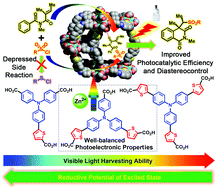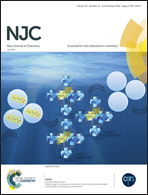Thiophene insertion for continuous modulation of the photoelectronic properties of triphenylamine-based metal–organic frameworks for photocatalytic sulfonylation–cyclisation of activated alkenes†
Abstract
Pharmaceutically meaningful conversions like photocatalytic sulfonylation call for the precise control of the photoelectronic properties of photocatalysts. A ligand engineering strategy of inserting different numbers of thiophenes into the scaffold of triphenylamine (TPA)-based ligands was developed to improve the visible light absorption, enhance the oxidation potentials of the ground states, and decrease the reduction potentials of the excited states, providing a powerful tool for continuous modulation of the photoelectronic properties of metal–organic framework (MOF)-based heterogeneous photocatalysts. The ligand inserted with two thiophenes was found to possess a well-balanced photoelectronic performance, endowing the corresponding MOF Zn–BCTA with good visible light-harvesting ability and a moderate excited-state reduction potential with minimal over-potential for the photoinduced generation of sulfonyl radicals while avoiding the competitive over-reduction of the sulfonyl moieties. The breaking of the C3-symmetry of the TPA-based ligand forged a distorted coordination geometry of the Zn4O nodes of the MOF to provide potential active sites to facilitate the fixation and activation of α,β-unsaturated carbonyl substrates, and the two-fold interpenetrated frameworks further enhanced the spatial proximity between the encapsulated substrate and the photoredox-active centre. The synergy of the well-tuned photoelectronic properties of Zn–BCTA and the spatial confinement effect within the pores benefited the tandem sulfonylation–cyclisation of unsaturated alkenes in an efficient and diastereoselective mode for the construction of bio-interesting sulphoyl isoquinolinediones/oxindoles.



 Please wait while we load your content...
Please wait while we load your content...